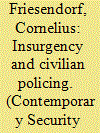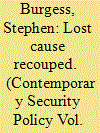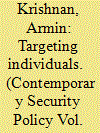|
|
|
Sort Order |
|
|
|
Items / Page
|
|
|
|
|
|
|
| Srl | Item |
| 1 |
ID:
123001


|
|
|
|
|
| Publication |
2013.
|
| Summary/Abstract |
Effective and legitimate policing is a necessary condition for the sustainable stabilization of war-torn countries. A crucial dilemma faced by international donors is whether to promote militarized or civilian policing. Particularly with insurgency and terrorism, police need robust capabilities to defend themselves and citizens against violence. At the same time, militarized police forces with weak oversight may fail to use proportionate force and serve the public. Little is known about management of this dilemma. This article argues that three established explanations - local security threats, international norms, and the political systems of donor states - do not determine the shape of police assistance programmes. Rather, the organizational cultures of donor police forces most crucially influence whether donors prioritize civilian or militarized police assistance. German support for the Afghan National Police (ANP) is a case in point. Despite deteriorating security and American pressure to support counterinsurgency, German police advisors stuck with a civilian policing model, due to their own organizational culture. Planners of foreign missions should better anticipate the organizational biases of specific donor agencies, this article concludes, to avoid frustration during the implementation phase.
|
|
|
|
|
|
|
|
|
|
|
|
|
|
|
|
| 2 |
ID:
123000


|
|
|
|
|
| Publication |
2013.
|
| Summary/Abstract |
A constitutional convention with representation from clan elders adopted a new constitution for Somalia on 1 August 2012, which paved the way for the election of a federal parliament and a new president of the Federal Republic of Somalia. This article examines two opposing explanations for this progress in a country long dismissed as a lost cause. Bottom-up stability, with grassroots equilibrium, is argued to be more likely to bring representation and renewal. The counter-hypothesis emphasizes security from the top down as more likely to lead to representation and renewal. Both hypotheses are evaluated here based on peacebuilding theory and evidence from Somalia and other relevant cases, including Afghanistan and the Democratic Republic of Congo (DRC). This review concludes that top-down security was possible and desirable in Somalia, paving the way for continued security efforts and stability work. The strategy of the African Union, European Union, and United States - supporting Burundi, Kenya, and Uganda with high-salience peace enforcement in Somalia - succeeded in bringing greater top-down security. The article explains that a combination of international assistance and training and increased combat effectiveness forced Al Shabaab out of Mogadishu and other urban centres. Western governments and international organizations continue to pursue top-down security as the best hope for ending war and restoring peace in Somalia. Top-down security, if properly implemented, can pave the way for bottom-up stability efforts and renewal and representation in Somalia, Africa, and elsewhere.
|
|
|
|
|
|
|
|
|
|
|
|
|
|
|
|
| 3 |
ID:
122998


|
|
|
|
|
| Publication |
2013.
|
| Summary/Abstract |
Is it better to publish or restrict potentially dangerous dual-use scientific research? This question sparked international attention in mid 2011 when two researchers separately sought to publish scientific studies that demonstrated that laboratory-derived strains of the highly pathogenic avian influenza H5N1 virus became capable of airborne transmission after a few genetic manipulations. These findings raised fears that the virus could become easily transmissible among mammals and that rogue actors could use the published information to create a biological weapon. In response, some governments sought to restrict or prohibit the publication of such research. Other actors countered that sharing this information was the best way to ensure national and international safety and security. In this article, I examine the competing demands between public health and national security by examining two dual-use research controversies. This article shows that the best solution to dual-use dilemmas in security-sensitive biological research is to promote an international norm of dual-use awareness. This balances the value of transparent scientific research with dual-use research's potential implications to provide the highest degree of security. Promoting a global norm, cognizant of potential consequences, would allow for scientific research to continue while ensuring that security considerations play a vital role in conditioning the scientific conversation. Such an effort need not be directed by governments; indeed, professional societies could and should take the lead in promoting such efforts.
|
|
|
|
|
|
|
|
|
|
|
|
|
|
|
|
| 4 |
ID:
122999


|
|
|
|
|
| Publication |
2013.
|
| Summary/Abstract |
Targeted killing is not new. What has changed is the nature of armed conflict, states that openly admit to the practice, and the emergence of much more capable technology. Targeting individuals seems to make sense given the changing nature of armed conflict. But whether targeting dangerous individuals is indeed legal, effective, and ethical is often impossible to determine, either in specific cases or systematically, because of the secrecy surrounding such operations. Calls from civil society and legislatures for greater transparency in targeted killings are unlikely to result in more openness or accountability, easily denied by the precedence of security claims for these intelligence-driven operations and covert actions. This barrier also makes it very difficult to develop consistent domestic and international rules for targeting individuals outside war zones. If states became more transparent about how and why individuals are targeted, the approach could gain more legitimacy. Rather than giving states a blanket legal authority of secretly killing individuals they deem terrorists or threats to national security, a workable solution could be a systematic preference to rely on non-lethal means in targeted counterterrorism operations with the aim of subsequent prosecution of captured individuals. A systematic preference for non-lethality should be accompanied by a requirement for the humane treatment of detained terrorists/combatants and a requirement for a fair trial after a specified period of detention. Secret prisons and indefinite detentions of terrorism suspects not charged with any crime should not be permissible practices in democratic states.
|
|
|
|
|
|
|
|
|
|
|
|
|
|
|
|
|
|
|
|
|